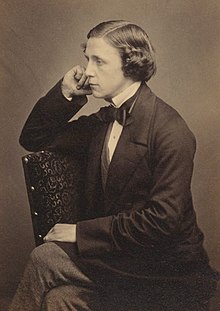
Lewis Carroll
British author and scholar (1832–1898) / From Wikipedia, the free encyclopedia
Dear Wikiwand AI, let's keep it short by simply answering these key questions:
Can you list the top facts and stats about Lewis Carroll?
Summarize this article for a 10 year old
Charles Lutwidge Dodgson (/ˈlʌtwɪdʒ ˈdɒdʒsən/ LUT-wij DOJ-sən; 27 January 1832 – 14 January 1898), better known by his pen name Lewis Carroll, was an English author, poet, mathematician and photographer. His most notable works are Alice's Adventures in Wonderland (1865) and its sequel Through the Looking-Glass (1871). He was noted for his facility with word play, logic, and fantasy. His poems Jabberwocky (1871) and The Hunting of the Snark (1876) are classified in the genre of literary nonsense.
Lewis Carroll | |
|---|---|
 Carroll in 1857 | |
| Born | Charles Lutwidge Dodgson (1832-01-27)27 January 1832 Daresbury, Cheshire, England |
| Died | 14 January 1898(1898-01-14) (aged 65) Guildford, Surrey, England |
| Resting place | Mount Cemetery, Guildford, Surrey, England |
| Occupation |
|
| Education | |
| Genre | |
| Parents | Charles Dodgson (father) |
| Relatives |
|
| Signature | |
Carroll came from a family of high-church Anglicans, and developed a long relationship with Christ Church, Oxford, where he lived for most of his life as a scholar and teacher. Alice Liddell – a daughter of Henry Liddell, the Dean of Christ Church – is widely identified as the original inspiration for Alice in Wonderland, though Carroll always denied this.
An avid puzzler, Carroll created the word ladder puzzle (which he then called "Doublets"), which he published in his weekly column for Vanity Fair magazine between 1879 and 1881. In 1982 a memorial stone to Carroll was unveiled at Poets' Corner in Westminster Abbey. There are societies in many parts of the world dedicated to the enjoyment and promotion of his works.[1][2]